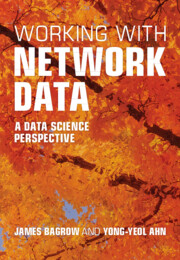Book contents
- Frontmatter
- Contents
- Preface
- Part I Background
- Part II Applications, tools, and tasks
- Chapter 5 The life cycle of a network study
- Chapter 6 Gathering data
- Chapter 7 Extracting networks from data — the “upstream task”
- Chapter 8 Implementation: storing and manipulating network data
- Chapter 9 Incorporating node and edge attributes
- Chapter 10 Awful errors and how to amend them
- Chapter 11 Explore and explain: statistics for network data
- Chapter 12 Understanding network structure and organization
- Chapter 13 Visualizing networks
- Chapter 14 Summarizing and comparing networks
- Chapter 15 Dynamics and dynamic networks
- Chapter 16 Machine learning
- Interlude — Good practices for scientific computing
- Part III Fundamentals
- Conclusion
- Bibliography
- Index
Chapter 9 - Incorporating node and edge attributes
from Part II - Applications, tools, and tasks
Published online by Cambridge University Press: 06 June 2024
- Frontmatter
- Contents
- Preface
- Part I Background
- Part II Applications, tools, and tasks
- Chapter 5 The life cycle of a network study
- Chapter 6 Gathering data
- Chapter 7 Extracting networks from data — the “upstream task”
- Chapter 8 Implementation: storing and manipulating network data
- Chapter 9 Incorporating node and edge attributes
- Chapter 10 Awful errors and how to amend them
- Chapter 11 Explore and explain: statistics for network data
- Chapter 12 Understanding network structure and organization
- Chapter 13 Visualizing networks
- Chapter 14 Summarizing and comparing networks
- Chapter 15 Dynamics and dynamic networks
- Chapter 16 Machine learning
- Interlude — Good practices for scientific computing
- Part III Fundamentals
- Conclusion
- Bibliography
- Index
Summary
Much of the power of networks lies in their flexibility. Networks can successfully describe many different kinds of complex systems. These descriptions are useful in part because they allow us to organize data associated with the system in meaningful ways. These associated attributes and their connections to the network are often the key drivers behind new insights. For example, in a social network, these may be demographic features, such as the ages and occupations of members of a firm. In a protein interaction network, gene ontology terms may be gathered by biologists studying the human genome. We can gain insight by collecting data on those features and associating them with the network nodes or links. In this chapter, we study ways to associate data with the network elements, the nodes and links. We describe ways to gather and store these attributes, what analysis we can do using them, and the most crucial questions to ask about these attributes and their interplay with our networks.
Keywords
Information
- Type
- Chapter
- Information
- Working with Network DataA Data Science Perspective, pp. 105 - 116Publisher: Cambridge University PressPrint publication year: 2024
